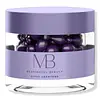What's inside
What's inside
 Key Ingredients
Key Ingredients

 Benefits
Benefits

 Concerns
Concerns

No concerns
 Ingredients Side-by-side
Ingredients Side-by-side

Cyclopentasiloxane
EmollientDimethicone Crosspolymer
Emulsion StabilisingZinc Oxide
Cosmetic ColorantCucumis Melo Fruit Extract
Skin ConditioningMyristoyl Pentapeptide-8
Skin ConditioningMyristoyl Tetrapeptide-8
Skin ConditioningOryza Sativa Extract
AbsorbentHelianthus Annuus Seed Oil
EmollientLupinus Albus Seed Extract
Skin ConditioningOlea Europaea Fruit Oil
MaskingSimmondsia Chinensis Seed Extract
AbrasiveTocopherol
AntioxidantGlycerin
HumectantDimethiconol
EmollientMethyl Methacrylate/Glycol Dimethacrylate Crosspolymer
Hydroxypropyltrimonium Maltodextrin Crosspolymer
Cyclopentasiloxane, Dimethicone Crosspolymer, Zinc Oxide, Cucumis Melo Fruit Extract, Myristoyl Pentapeptide-8, Myristoyl Tetrapeptide-8, Oryza Sativa Extract, Helianthus Annuus Seed Oil, Lupinus Albus Seed Extract, Olea Europaea Fruit Oil, Simmondsia Chinensis Seed Extract, Tocopherol, Glycerin, Dimethiconol, Methyl Methacrylate/Glycol Dimethacrylate Crosspolymer, Hydroxypropyltrimonium Maltodextrin Crosspolymer
Water
Skin ConditioningGlycerin
HumectantCoco-Caprylate/Caprate
EmollientHelianthus Annuus Seed Oil
EmollientOctyldodecanol
EmollientHydroxypropyl Starch Phosphate
Pentylene Glycol
Skin ConditioningSesamum Indicum Seed Oil
EmollientAcacia Senegal Gum
MaskingMethyl Glucose Sesquistearate
EmollientAphloia Theiformis Leaf Extract
AstringentPropanediol
SolventTribehenin
EmollientHydroxyacetophenone
AntioxidantStearyl Alcohol
EmollientParfum
MaskingXanthan Gum
EmulsifyingEthyl Linoleate
Emollient1,2-Hexanediol
Skin ConditioningCaprylyl Glycol
EmollientLecithin
EmollientSodium Stearoyl Glutamate
CleansingCitric Acid
BufferingSodium Hyaluronate
HumectantTrisodium Ethylenediamine Disuccinate
Mesembryanthemum Crystallinum Extract
HumectantLinalool
PerfumingAlginic Acid
Skin ConditioningSilanetriol
Geraniol
PerfumingPropyl Gallate
AntioxidantWater, Glycerin, Coco-Caprylate/Caprate, Helianthus Annuus Seed Oil, Octyldodecanol, Hydroxypropyl Starch Phosphate, Pentylene Glycol, Sesamum Indicum Seed Oil, Acacia Senegal Gum, Methyl Glucose Sesquistearate, Aphloia Theiformis Leaf Extract, Propanediol, Tribehenin, Hydroxyacetophenone, Stearyl Alcohol, Parfum, Xanthan Gum, Ethyl Linoleate, 1,2-Hexanediol, Caprylyl Glycol, Lecithin, Sodium Stearoyl Glutamate, Citric Acid, Sodium Hyaluronate, Trisodium Ethylenediamine Disuccinate, Mesembryanthemum Crystallinum Extract, Linalool, Alginic Acid, Silanetriol, Geraniol, Propyl Gallate
Alternatives
Ingredients Explained
These ingredients are found in both products.
Ingredients higher up in an ingredient list are typically present in a larger amount.
Glycerin is already naturally found in your skin. It helps moisturize and protect your skin.
A study from 2016 found glycerin to be more effective as a humectant than AHAs and hyaluronic acid.
As a humectant, it helps the skin stay hydrated by pulling moisture to your skin. The low molecular weight of glycerin allows it to pull moisture into the deeper layers of your skin.
Hydrated skin improves your skin barrier; Your skin barrier helps protect against irritants and bacteria.
Glycerin has also been found to have antimicrobial and antiviral properties. Due to these properties, glycerin is often used in wound and burn treatments.
In cosmetics, glycerin is usually derived from plants such as soybean or palm. However, it can also be sourced from animals, such as tallow or animal fat.
This ingredient is organic, colorless, odorless, and non-toxic.
Glycerin is the name for this ingredient in American English. British English uses Glycerol/Glycerine.
Learn more about GlycerinHelianthus Annuus Seed Oil is the oil derived from the seeds of a Sunflower. Sunflower seed oil is non-fragrant. It is an emollient, meaning it helps to soften the skin.
Sunflower seed oil contains many fatty acids. The fatty acids found in sunflower seeds include (from highest amount to least): linoleic acid, myristic acid, palmitic acid, stearic acid, arachidic acid, oleic acid, and linolenic acid.
These fatty acids help the skin create ceramides. Ceramides play a role in repairing the skin barrier.
Helianthus Annuus Seed Oil helps moisturize the skin. This in turn helps the skin look more rejuvenated and smoother.
Sunflowers are rich in vitamin E.
Historians believe Indigenous cultures of North America domesticated sunflowers before corn. Thus they relied on sunflower oil for a variety of uses. One such use is moisturizing skin and hair.
Sunflower seed oil may not be fungal acne safe. We recommend speaking with a professional if you have any concerns.
Learn more about Helianthus Annuus Seed Oil